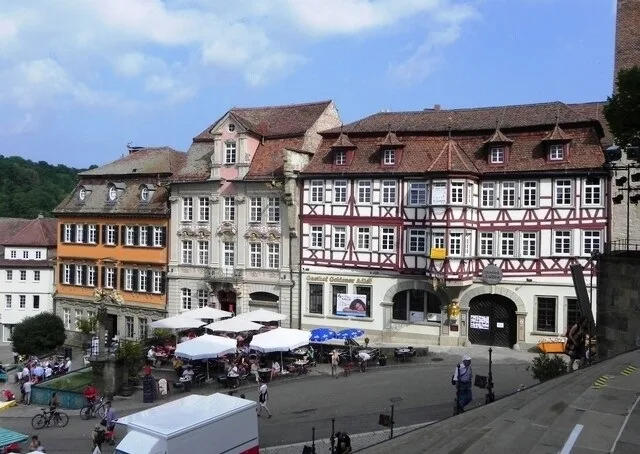City of Schwäbisch Hall is located in the north-eastern part of Baden-Württemberg. The city is the center of a district in the Stuttgart district. Schwäbisch Hall stands on the Kocher River.
 |
| Schwäbisch Hall |
History
The city was known in the old days as Hall. Clarification "Schwäbisch" (that is, Swabian) appeared already in 1934, so as not to confuse Hall with his namesakes in Austria and other regions of Germany The toponym "Hall", apparently, goes back to the ancient Celtic word for "salt". Salt has been mined in the area of the city since the 5th century BC. Until the first half of the 20th century, the main salt industry in Germany was located here.
 |
| Schwäbisch Hall |
Hall was first mentioned in 1063 as the possession of the Counts of Comburg. In 1106, the count bequeathed Hall to the Abbey of Comburg, but the emperor Frederick Barbarossa intervened, who handed the city over to the Staufen family, his relatives. Soon a mint appeared here, minting "gallers", which were widely used in many European countries.
Schwäbisch Hall was rich in salt mining and minting, and in 1280 received the status of a free imperial city. And since then it has been ruled by burghers.
 |
| Schwäbisch Hall |
In the Thirty Years' War (1618/48) Hall was not destroyed or besieged, but suffered from the looting of the enemy armies and exorbitant payments to the armies participating in the conflict. And in 1634 the population was knocked down by the plague. Severe fires in 1680 and 1728 destroyed part of the old buildings, forcing the modernization of Hall. This is how baroque buildings appeared in the city.
In 1803 Hall was stripped of its status as an imperial city. At the same time, it was annexed to the elector (from 1806 - the kingdom) of Württemberg. By that time, the economic condition of the city left much to be desired. The situation was corrected by the railway, which was built in Halle in 1862. In the 19th century, a sanatorium operated in the city, and the well-preserved historic center made Hall a center of nascent tourism.
 |
| Schwäbisch Hall |
In the 1930s, the Luftwaffe barracks were located on the outskirts of Schwäbisch Hall. However, during the bombing of the Allies, the city itself suffered little, mainly to the suburbs. After the war (until 1993), American troops were stationed in Schwäbisch Halle.
Sights
The modern appearance of the historical center was finally formed after the fire of 1728. In the old town there are many both baroque buildings and half-timbered houses, which are located mainly along the coast of Kocher.
The main church of the city is the Protestant Church of St. Michael (15th century). It is a hall church in the Sondergothic style with a tower, stone sculptures and frescoes inside, stained glass windows and an ossuary.
The historic temples of Schwäbisch Hall are the chapel of St. Jodok (13th century), rebuilt into a passage tower and the hospital church of the Holy Spirit (13th century). The latter is part of the complex of buildings of the Hospital of the Holy Spirit - one of the oldest in the country.
 |
| Schwäbisch Hall |
The architectural monuments include the Baroque Town Hall (1735), the Old Arsenal (16th century), once the largest building in Hall (now a concert hall) and several towers left over from the city fortifications.
To the south of the city, towering over the Kocher Valley, is the Kombourg Monastery. Founded in the 11th century, the monastery was an imperial abbey (14-16th centuries). Comburg has preserved its medieval fortifications, which is rare in Western and Central Europe. Inside the walls is an ensemble of baroque buildings.
